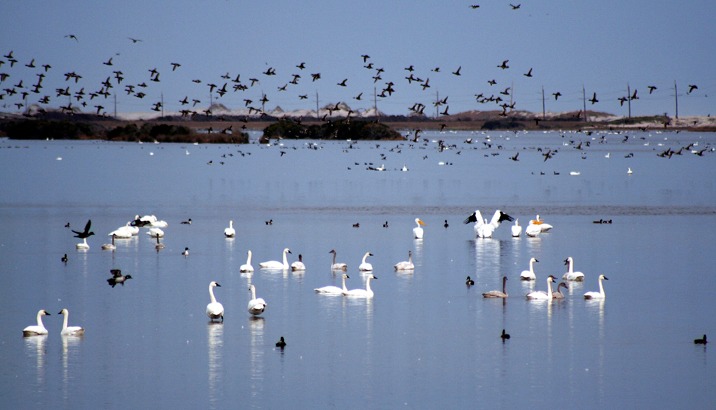Chicamacomico Banks Water Rescue’s 30th season is a busy one
It’s a surprisingly hot late September afternoon on Hatteras Island, and a trio of beach-goers on the Rodanthe shoreline near Sea Isle Hills Drive have decided to cool off by jumping into the ocean for a swim – right in front of a posted sign that warns of rip currents in the immediate area.
Chet Bailey, the captain of the Chicamacomico Banks Water Rescue team, sits in his idling rescue pickup truck and watches to make sure the impromptu dip doesn’t lead to a disaster.
It seems odd that someone would go swimming in front of a rip current sign, but as it turns out, it’s not an unusual occurrence.
“Sometimes it seems like the [rip current] signs are like magnets,” says Chet with a laugh, “but our big problem here is that people don’t know what rip currents are”.
It’s an exercise that the 14-member rescue team is used to, and they’ve become experts on knowing where the hot spots for rip currents are located — and posting signs alerting the public — as well as spotting any swimming activity that could lead to a problem. From there, a response to someone being swept away takes place within minutes, if not seconds, as the crew relies on skills that are acquired from continual twice-a-week training sessions.
The Chicamacomico Banks Water Rescue is celebrating its 30th year of operation in 2016. The formerly all-volunteer team was founded in 1986 to patrol the tri-village area beaches and beyond and assist with rescues as needed.
The original volunteer organization has since become funded and that has allowed for paid positions – although all members pretty much need to have other part-time jobs on the Outer Banks to foot the bills.
“This isn’t something you do for the pay,” says Chet. “You do this because you want to help your community.”
And while the funds are severely limited – and the Chicamacomico Banks Water Rescue team is always appreciative of donations – the workload for the team has clearly risen since its 1986 roots.
Chet Bailey joined the Water Rescue team in 1994 and was named captain in 2009.
“Twenty years ago, there were maybe six calls a year, and now there are 140,” he says. “I remember when I first joined, I really wanted to rescue somebody. Now I think, ‘Please… I have to catch my breath!’”
The Chicamacomico Banks Water Rescue team has certainly had a busy 30th summer season.
To date, the team has reported 101 persons rescued in the ocean, seven persons rescued in the sound — typically from a malfunctioning vessel or Jet Ski — 63 Emergency Medical Service calls to assist in a situation, nine missing persons found, eight people with mobility issues assisted to the beach, and two kiteboarders assisted.
Among this impressive list of feats, however, is also a count of two drownings, which occurred just a couple weeks ago at a posted rip current hot spot.
“We had talked to them about rip currents [before the incident], and one of our trucks had just driven by when they went in the ocean,” says Chet.
Apparently, a man had swum out into the water, gotten caught in the current, and several others swam out to save him. The Chicamacomico Banks Water Rescue team responded to the call in less than a minute, but at that point, there was nothing that could be done. The man and one of his would-be rescuers died.
“It was heartbreaking,” says Chet.
Unfortunately, rip current-related deaths and incidents have become an island-wide problem – a sentiment that is echoed by Hatteras Island District Ranger Joseph Darling of the National Park Service.
“…it has been a very deadly summer and we continue to pull people from the water on almost a daily basis,” said Darling in a statement. “This summer many visitors have needed minor assistance to reach the shoreline, others visitors have needed major assistance (long hospitalizations, successful CPR, and life flights) and five visitors have died in the seashore.”
The reason for the increased rescue activity for the Chicamacomico Banks Water Rescue team boils down to an increase of new visitors, according to Chet.
“More and more people are coming here who have never been here before,” he says, “and everyone I talk to says ‘This is my first time here, but I am coming back forever!’”
In addition to this new wave of visitors, the tri-villages are also home to a number of rip current hot spots which can stick around for years at a time, and which are especially prevalent around low tide. A tropical system or storm can exacerbate these conditions, and can introduce new rip currents to the shoreline, or can re-introduce dormant rip currents to the area.
“The rip current near the KOA Campground had lost strength, but reappeared after Hermine,” says Chet, citing an example. “We have a couple established rip currents that we know will [be around] during low tide, and we’re always checking them.”
With various tropical storms hanging around offshore for days at a time, the National Weather Service has issued many days of high rip current warnings for the area. In fact, there have been more days in which the rip current risk has been high during September than days in which it has been moderate or low.
The crew patrols the shoreline daily during the height of the summer season from the southern region of the Bonner Bridge to the area in between the towns of Avon and Salvo, but spends the bulk of their time along the beaches of Salvo, Waves, or Rodanthe.
Not only does this route give them proximity to the most populated stretch of northern Hatteras Island, which is where rescue calls are likely to occur, but it also gives them a better opportunity to talk with the public.
“We spend a lot of time talking to people, and telling them about rip currents – and people are very responsive to it,” says Chet. “Honestly, we could spend all day talking to people on the beach, and getting info out to them.”
And some of the methods that the team uses to foster education on rip currents is pretty ingenious.
On several recent popular beach weekends, the crew has distributed harmless red or neon green dye into the water, to highlight the lightning-fast path it makes out into the ocean waters when it’s distributed into the middle of a rip current. One such example brought a crowd to the shoreline in front of the KOA campground — one of the most popular beach areas and also home to a years-old rip current — accomplishing a mass education in one fell swoop.
And on more frequent occasions — simply because massive amounts of dye are expensive but ap parently crew members are not — the team will jump into the water, get swept out to sea, and will physically demonstrate how to swim parallel to the shoreline to effectively “get out” of the rip current.
Considering that an estimated 97 percent of the Water Rescue Team’s calls are related to rip currents, the live demonstrations – even if it involves getting sucked into the ocean – are worth the effort.
“We also try to talk to people on Mondays, when they are just starting their beach vacation,” says Chet. “Getting the word out is one of our primary goals.”
To that end, the 30-year-old team is finding new and modern ways to spread the word about rip current risks, starting with regular postings on water and weather conditions on their Facebook page, https://www.facebook.com/Chicamacomico-Banks-Water-Rescue-28088 8235403636/?fref-ts.
This, combined with talking to folks on the beach and doing live demos, helps alleviate the problem, albeit the Chicamacomico Banks Water Rescue responds to all nature of calls.
Because the organization is so closely tied to the Chicamacomico Banks Volunteer Fire Department, and even shares the same space close to Atlantic Drive, it’s not unusual at all for members to be involved in both of the organizations, or the Dare County EMS. Chet, for example, is the deputy chief of the Chicamacomico Volunteer Fire Department, and one member of the crew is “retired” after a 30-year-long career as an EMS flight medic for Dare County.
“We are very lucky to have him,” says Chet.
Because of these close ties, Water Rescue can address all nature of calls ranging from someone being stuck in a vacation rental home elevator to a structural fire in the tri-villages. And while these off-the-beach jobs are not directly tied to water rescue to be sure, they do have their rewarding moments.
For example, on roughly a half dozen occasions in 2016, the water rescue team has been called upon to supply transportation for a disabled person who could not access the beach without assistance.
“That’s probably the most rewarding aspect of the job,” says Chet. “[These people] are so grateful to get to the beach, and we’re happy we can help.”
The Chicamacomico Banks Water Rescue team also has a beach-access wheelchair that it freely lends out to the public when called upon, to make getting to the beach easier.
And while the small and rewarding tasks of helping someone visit the Hatteras Island seashore may be few and far between – especially when compared to the roughly two to four calls per day that require a harried jump into the ocean, and up to 10 calls on a busy beach day, the crew members continue to find rewards in all aspects of the job, 30 years after the Chicamacomico Banks Water Rescue began.
“Some of the people we rescue will send us letters and maybe even send us a donation,” says Chet. “And getting a follow-up letter from someone is really amazing… We have an incredible crew, and we all love our jobs”
HOW TO VOLUNTEER
The Chicamacomico Banks Water Rescue is always looking for new volunteers and members.
“You got to know how to swim,” says Chet, “but we’ve had volunteers who have had no experience with the ocean.”
HOW TO DONATE
Visitors can send a check to the Chicamacomico Banks Water Rescue at the following address:
Chicamacomico Banks Water Rescue, P.O. Box 304, Rodanthe, NC 27968.
Visitors can also send a check to the all-volunteer Hatteras Island Rescue Squad, which covers the southern Hatteras beaches in Avon, Buxton, Frisco, and Hatteras village at the following address: Hatteras Island Rescue Squad, P.O. Box 639, Buxton, NC 27920.
HOW TO SPOT RIP CURRENTS













